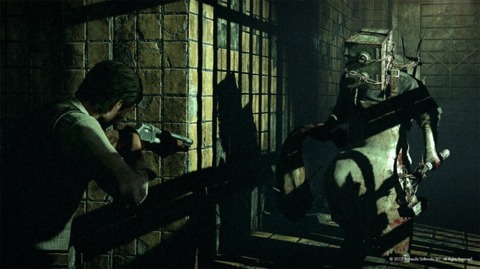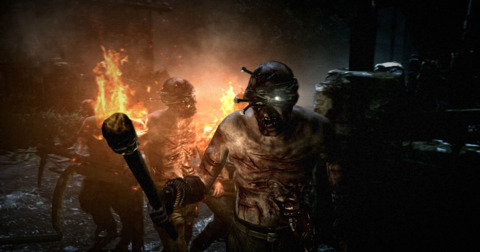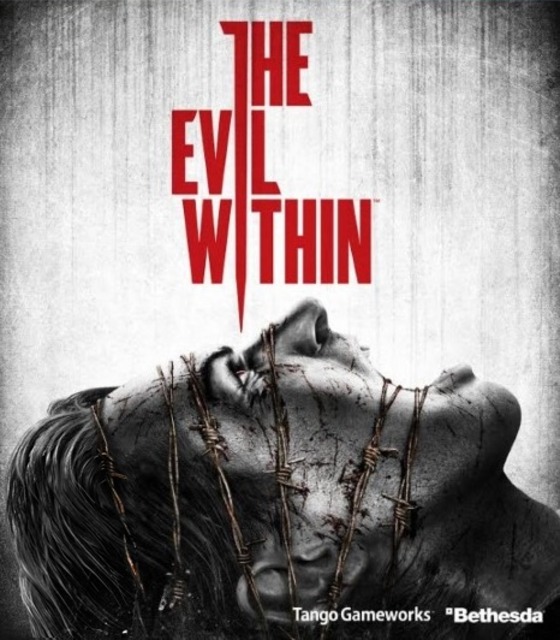While archaic and occasionaly clunky, The Evil Within is still a tense and memorable survival horror experience
“You have an odour of blood about you” chimes the nurse, but she doesn’t know the half of it. I’m safe now, though, in this… place. I’m still not quite sure what to make of it yet, drawn to its whereabouts, as I was, by Debussy’s Clair de lune – the Frenchman’s stirring composition acting as a beautiful beacon amidst this violent chaos.
The aesthetic is that of a mental hospital – all locked cells; sterile, “smells like medicine”. It’s ostensibly a safe haven, yet one that maintains a sense of unease inherent in the unknown. Things don’t always stay the same from visit to visit, subtly twisting and contorting various details like the evil is slowly clawing away at the walls, trying to get in. The nurse refuses to provide answers but is nonetheless a friendly and familiar face, even if I don’t quite trust her. She asks me to save my game at her desk before I enter a grimy cell, upgrading my abilities and weapons by injecting green gel into my brain using a cruel-looking lobotomy machine.

All of this to say The Evil Within isn’t the least bit concerned with normalcy. This odd hub zone is just the tip of the iceberg in what is a strange, strange game and a conceptual departure for legendary Japanese developer Shinji Mikami. It delves into psychological horror in ways Resident Evil wouldn’t dare to – leaving those antics to the likes of Silent Hill – while never quite venturing too far from Mikami’s survival horror roots. Hell, your first encounter with its pseudo-zombies is essentially a shot-for-shot remake of your first encounter with the undead in the original Resident Evil, and the homages don’t end there. Resident Evil 4’s influence never strays too far from its combat either.
The Evil Within is more unnerving and creepy than it ever is truly terrifying, with more action than we’re regularly accustomed to in a survival horror game. It’s a transmogrification of the genre in the mould of Resident Evil 4, where the tension exudes from its panic-inducing combat and how capably you can manage a scarcity of resources against a horde of ever-increasing enemies. “Survival” becomes the key word.
It’s as immediately engaging as Resident Evil 4, too, mixing accomplished gunplay with some deft strategy and gruesomely satisfying kill shots. Whether you’re using the pistol, shotgun or sniper rifle, the shooting never tires, each missed shot prone to a cuss-filled outbreak as you curse your dwindling supplies. It’s so effective because every single shot feels critical; not only are you low on bullets but you’re more vulnerable than any action hero ever has been. Protagonist Sebastian Castellanos is not the consummate badass like Leon Kennedy, he’s just a regular guy thrust into a dire situation. He can barely sprint without needing to pause and catch his breath, and his aim wavers just enough to make each pressure-filled shot feel that little bit more tense.
Headshots quickly become a favourite strategy. Risky to execute when the grotesque are edging closer, but oh so rewarding when you pop off an inch perfect headshot and send brain matter splaying over everything and anyone unfortunate enough to be in the way. The bodily deformation is quite the sight to behold.
Shots to the legs work just as well, too. With a box of matches handy it only takes one match to ignite a fallen enemy, handily engulfing any others who would dare tread too close if timed right. With a decidedly weak melee attack, matches are the most useful way to conserve ammunition, akin to Leon’s overpowered array of roundhouse kicks and head-shattering backflips. Burning bodies may not be as entertaining as executing a perfect German suplex on a shambling Ganado, but lighting up a few at once comes pretty close.

Your most important and distinctive weapon, however, is the Agony Crossbow. With multiple bolts to choose from it’s a varied weapon to be used in a myriad of different ways. The regular bolt is for your usual impaling, then you can get a little more creative with things like the flash bolt that lets you score an easy one-hit kill on stunned enemies, or the freeze bolt that completely freezes enemies in ice, allowing you to smash them into tiny pieces.
You can also shoot bolts at surfaces to create dynamic traps, gaining a tactical edge to protect your blindside or take out a few enemies at once using a well-placed explosive bolt. With other traps already dotted around the environment (including trip wires and bear traps) you can choose to either disarm them for the parts needed to create more crossbow bolts or turn the tables and use them against your enemies. Each location, small as they often are, feels like a playground for experimentation. Every combat scenario forces you to be creative and resourceful; the plethora of tools at your disposal creating exciting, emergent moments.
You can even try the stealth route, if you so desire; though this feels a little half-baked. Since you’re dealing with such unnatural creatures they don’t exactly follow a specific patrol pattern as they wander around each area. Their movements are unpredictable and they have a habit of turning around just as you’re about to stab them in the back.
You also move exceedingly slow while crouching, and the lack of a cover system results in lots of situations where you’re awkwardly angling yourself near corners to try and glance around them, battling a camera that’s fond of getting too close and movement controls that are a tad clunky. I executed roughly a dozen stealth kills over the course of the game but it never felt like a particularly viable option, especially since the opportunity to go silent doesn’t present itself too many times throughout The Evil Within’s fifteen or so hours.
With some lengthy load times and multiple enemy types with one-hit kills, it can grow a little frustrating at times (I daren’t try the Akumu difficulty, where a single hit equals death, no matter what). And I imagine quite a few people will take issue with the 2.5:1 aspect ratio and its pervasive black bars. This letterboxing certainly contributes to a feeling of claustrophobia but otherwise appears needless, at least on a technical level. Performance is still rather hit-and-miss with some terrible texture pop-in and a fluctuating framerate, despite having much less screen space to render, and there’s no cinematic value to be gleaned from its use when the atmosphere is already as phenomenal as it is.

The Evil Within looks like the best horror movie ever made with its chilling and imaginative art direction, and a fantastic use of lighting that does more than this letterboxing ever could. Despite my initial gripes I did eventually forget the black bars were there after a few hours, and I’m finding it increasingly difficult to argue against it if this is, in fact, Mikami’s artistic vision. It’s supposed to be divisive, right? But this is still a barrier some may not be able to look past, and that’s unfortunate.
While The Evil Within nails its atmosphere, the story that accompanies it is disappointing. Other than having the most cop name a cop could ever have, Sebastian Castellanos is also as dull and wooden as they come. He has the “gruff cop with a dark past” angle down pat, and the overarching narrative doesn’t fare much better either, lacking any sort of coherency with some bland writing and a surprising absence of momentum.
This is partly due to a plot device that allows the action to erratically jump from location to location on a whim. This works fantastically on a mechanical level, drastically shifting the action from one distinct locale to another. You’ll go from being in a classically eerie mansion to an underground maze of ancient ruins, to a contorting cityscape that looks like it was pulled from Inception. There’s a striking variety to every location and each is a treat to explore, yet this constant shuffling hampers the narrative flow. The moment-to-moment pacing is near immaculate, but the overarching story rarely feels like it’s building towards any sort of meaningful conclusion, so I found it difficult to care either way.
I guess an underwhelming story is to be expected, though. For better or worse, The Evil Within is essentially Mikami’s survival horror greatest hits. For all his qualities – and there are many – storytelling has never been his forte, yet that seems like a moot point when this is probably the closest we’re ever going to get to a worthy successor to Resident Evil 4. For as archaic and clunky as that sometimes makes it, I can’t help but love The Evil Within for that very reason, and for the ways in which it alters that seminal formula to forge a completely different experience, all it’s own. It’s why I immediately began new game plus once the credits had rolled, and why I ended up completing it twice in less than a week. That’s the Mikami effect. If you’ve ever fallen under his spell, The Evil Within will most certainly have something for you.
